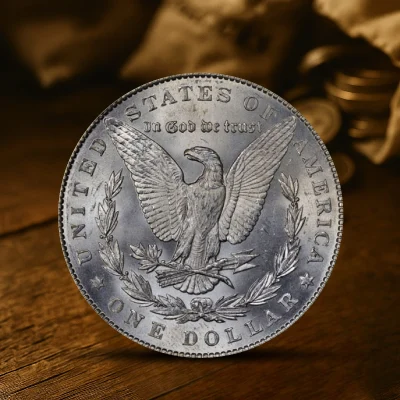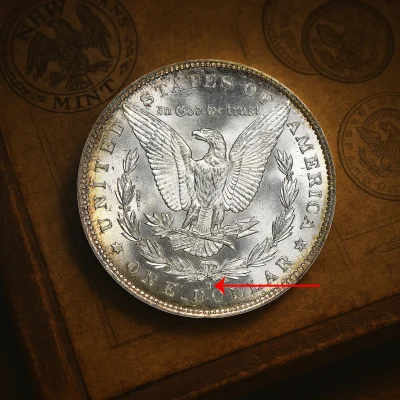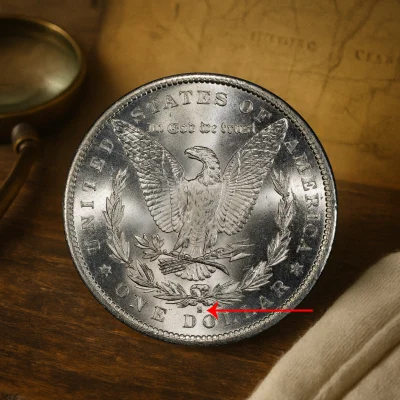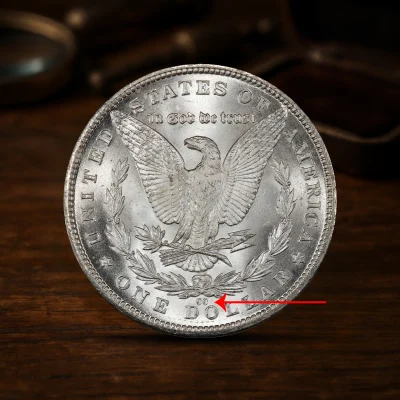
The 1890 Morgan Silver Dollar is one of the sought-after collectibles that has a rich history and remains popular. Wondering about the 1890 Silver Dollar value? It has a very wide range due to the mint mark, condition, and rare errors.
This guide takes the reader through grading advice, variety, and everything else that has to do with Carson City.
The 1890 Morgan silver dollar is an heir to an eventful era sometimes known as the Silver Age of late-19th-century America. Morgan dollars were struck between 1878 and 1904 (and once more in 1921) and were the large silver pieces which were named after their designer, George T. Morgan. On the obverse (front) of the coin, the profile of Liberty (based on the likeness of the model Anna Williams of Philadelphia) is depicted, and, on the reverse (back), a heraldic eagle with open wings.
These were the coins created by the Bland-Allison Act of 1878, which made the Treasury purchase silver to mint coins, and later they were affected by the Sherman Silver Purchase Act of 1890, which further strengthened the silver buying.
Morgan dollars were also produced in 1890 at four different mints, which were all marked on the reverse (under the eagle). These include:
The Philadelphia issue was by far the highest minted in 1890, with the Carson City issue being the lowest. Morgans with Carson City (CC) originals are typically less common and therefore coveted by those who collect them, and that is how there is a significant difference in value.
The Morgan dollars of 1890 are all of the same design and specifications. The coins are 90% silver and 10% copper, having a weight of 26.73 grams and a diameter of approximately 38.1mm. A dollar was quite a lot of money in 1890, and these heavy silver coins were used not only in the American West but were also kept in the vaults of banks. Numerous examples managed to stay in uncirculated condition throughout many years, and that is particularly true of the issues that were Treasury hoards that were sold at the beginning of the 20th century.
This implies that 1890 Morgans are old (more than 130 years), but not very rare in lower circulation grades, as millions were produced, and there are still a lot of them. Nevertheless, top-quality examples and some mint marks (such as the 1890-CC) will have a hefty premium added to them, as we will mention below.
The condition or grade of a 1890 silver dollar is one of its greatest determinants in value. Coins can be described as having status in circulation (they have observed signs of wear) or not in circulation (they are in a condition referred to as mint state because they exhibit no evidence of wear due to commerce). Let’s break down how condition affects the 1890 silver dollar value:
Circulated 1890 Morgan Dollars: Usually sells between 30 and 70 dollars each, again, with the common caveat, depending on wear. They are traded at a few cents above the silver melt value, commonly. The examples of F or XF can be up to 60 70
Uncirculated 1890 Morgans: MS60 at E75-E100. Examples like MS63-MS65 can cost a couple of hundred dollars. They can go into the thousands when they are eye-catching or top-grade.
The higher-quality coins in pristine condition and with attractive toning or prooflike fields are, in a very few instances (collector level), worth five figures, sometimes much more at auction.
Condition truly drives the 1890 Silver Dollar value across all markets.
Along with the condition, the mint mark of your 1890 silver dollar is also very important when evaluating value. These, as indicated, were four mint dollars struck in 1890, some of which are rarer than others:

In 1890, Philadelphia minted more than 16.8 million Morgan dollars, and since this was the most inted variety, it is the most common. They generally sell in the range of 30 and 60 dollars in circulated grades. Due to Treasury bag hoards, the uncirculated examples can be found fairly readily and start at around 75 (MS60), with MS65 coins valued between 200 and 300 dollars. The collectors tend to like the coins of this mint, as they can purchase them in any grade and at a reasonable price.
This problem is a good starter coin since there are a number of well-preserved issues available in the market. To conclude, it is an affordable and well-liked choice among people who want to collect a classic Morgan dollar.

The 1890-O Morgan silver dollar was minted in the New Orleans Mint and has a hefty mintage of approximately 10.7 million coins. But the biggest problem is that a lot of them have poor strikes, which brings down their aesthetic value and sellability as higher-grade pieces. The circulated coins sell between 32 and 70, with Mint State Premium variations being as high as MS60, which opens at 100 and 115.
Examples with strike problems are much less common in MS65 and may fetch $1,000 and up. Some of the varieties and errors add value to a collector. On the whole the 1890-O is a very common example in any grade but becomes a very desirable selection in gem and is one among the first to be chosen by high-grade Morgan dollar enthusiasts.

In 1890, the San Francisco Mint produced about 8.23 million Morgan dollars. These coins are well struck, and people will prefer to collect them. Examples that circulated have the same value as any other mint, i.e., generally 30 to 90 dollars. Unc examples start as low as $100 for mint state 60 and then rise in value steadily by grade: mint state 63 at $200, mint state 64 at $350, and mint state 65 at up to $900.
Very high-grade examples, MS67, are very rare and may fetch five figures—one of them realized $17,250 at auction. Overall, the 1890-S is highly attractive in eye appeal and has a fairly consistent value in Mint State, which makes it a good collectible coin.

The total amount of Morgan dollars by the Carson City Mint was only about 2.3 million in 1890, resulting in 1890-CC being the rarest and most desirable variation. Even the most used coins are at least two-thirds of that, irrespective of whether they are in a better circulated state, and go up to over seven hundred and fifty. No wonder uncirculated pieces are particularly desirable: the MS60 at around 1,050 dollars, the MS65 gems are worth over 5,000 dollars.
In 2015, an MS66 gem had garnered a mind-boggling price of 58750. This is increased by the fascination of the CC mint mark and its relation to the western U.S. history. It is also notable that there is a good proportion of a Rare type this year, the so-called Tail Bar, which makes the value even better from the point of view of specialized collectors.
Your 1890 Morgan dollar can have a value greatly influenced by the mint mark. It is found on the back of the currency above the D and O of the dollar, where it identifies the origin of the coin. A Carson City mint mark that designates a coin with a CC stands for a coin having hundreds or thousands of values. A New Orleans (New Orleans) or a San Francisco (San Francisco) overdate can also be valued, particularly in the uncirculated state.
No mint mark means that it was minted in Philadelphia, which is most common. This is the most important thing to know about the coin because then you can know how much to value it, and also you will not miss a valuable one in your collection. When you are about to estimate the fair value of your coin, always ensure that you examine the mint mark.
With its significant die variations and mint errors, the 1890 issue appeals to many collectors, particularly the so-called VAM collectors, who follow the VAM (Van Allen and Mallis) catalog of dies used by the San Francisco Mint. These are able to increase the value of the coin in terms of rarity and demand.
The best known variety is the 1890-CC, the “Tail Bar” (VAM-4) with a raised line extending the laurel wreath to the feathers of the eagle's tail. This is also the line of a die gouge and occurs only on Carson City coins. Dollar valued copies can range between 2,000 to 6,000 dollars, with DMPL versions going up to 9,000 and more. There are high-grade auction pieces that are worth more than 20,000.
This New Orleans variety has doubling on the ear of Liberty. Collectors want it and even in mint condition, it fetches a premium.
There is a spike-like gouge in the neck of the eagle. It is not dramatic; however, it attracts the attention of the die variety collectors and provides an increment in high grades.
Errors such as major misstrikes like the off-center, are worth up to $5,000. The minor flaws on die cracks or planchet cracks are usually valued at between $50 and 100. An extremely scarce 1890-CC issue, the so-called Reverse Lamination variety, graded MS63, realized a price in excess of $2,800.
These are not faults, but they are very attractive. An 1890-O MS66 PL made $12,000, and this was an indication of how surfaces affected value.
Always remember that when you are collecting 1890 Morgan silver dollars, two guiding factors to follow are condition and originality. Naturally brighter, uncleaned coins are better long-term investments, MS63 or above. The 1890-CC is the most important rarity, the perfect one to invest in, and Philadelphia, New Orleans, and San Francisco are more reasonable to buy.
A coin should never be collected that has been cleaned or is damaged because it no longer attracts collectors or brings the collectors value. In case you think that your coin may be odd or uncorrupted, you can have it graded by PCGS or NGC, which gives your coin more credibility and an option to change it in the future. Look at the price of silver and the trend of auctioning, since both the bullion prices and the demand of the market influence the price.
Select a collecting strategy: date, mint mark, or one there alone. Even the circulated 1890 coins can be had with historic appeal at low prices. Lastly, keep coins in secure storage: inert storage and dry storage. You do not want to touch the faces—fingerprints can reduce value. 1890 Morgans run some risk of being a dull collection, but with a little attention, they can be a good investment and a pleasure to possess.
| Feature | 1890 Morgan Silver Dollar | Jefferson Nickel |
|---|---|---|
| Denomination | $1 | 5¢ |
| Size | 38 mm diameter | 21.2 mm diameter |
| Weight | 26.73 grams | 5 grams |
| Metal Composition | 90% Silver, 10% Copper | 75% Copper, 25% Nickel |
| Silver Content | ~0.773 troy ounces of silver | None (except wartime nickels, 1942–45) |
| Intrinsic Metal Value | ~$18–$20 (based on silver prices) | Just a few cents |
| Historical Period | 19th century (Old West, Frontier era) | From 1938 (Modern U.S., WWII era onward) |
| Designer | George T. Morgan (allegorical Liberty) | Felix Schlag (Jefferson + Monticello) |
| Collectibility | High—many rare mint marks and conditions | Low—only a few key dates/errors |
| Average Value Today | ~$40 in average circulated condition | 5¢ in average circulated condition |
| Target Audience | Collectors and bullion investors | Beginners, budget collectors |
| Visual Appeal | Classical, intricate allegory | Realistic presidential portrait |

Always remember that when you are collecting 1890 Morgan silver dollars, two guiding factors to follow are condition and originality. Naturally brighter, uncleaned coins are better long-term investments, MS63 or above. The 1890-CC is the most important rarity, the perfect one to invest in, and Philadelphia, New Orleans, and San Francisco are more reasonable to buy.
A coin should never be collected that has been cleaned or is damaged because it no longer attracts collectors or brings the collectors value. In case you think that your coin may be odd or uncorrupted, you can have it graded by PCGS or NGC, which gives your coin more credibility and an option to change it in the future. Look at the price of silver and the trend of auctioning, since both the bullion prices and the demand of the market influence the price.
Select a collecting strategy: date, mint mark, or one there alone. Even the circulated 1890 coins can be had with historic appeal at low prices. Lastly, keep coins in secure storage: inert storage and dry storage. You do not want to touch the faces-fingerprints can reduce value. 1890 Morgans run some risk of being a dull collection, but with a little attention, they can be a good investment and a pleasure to possess.
It is the polychromic 1890 Morgan silver dollar that has more than merely the face value; some are treasured as pieces of history, some as collectible items. Most coins issued in this year are common and may be worth about $30-50 in circulated grades, higher grades and rare mints may jack up the prices tremendously.
The most important thing is to know what you have. In order to make sure that the coin is genuine, the information in this guide will help you gauge its authenticity, determine the mint mark, and evaluate the condition of the coin. Even an heirloom is often revealed as a valuable gem, as well.
When you are curious, satisfy your curiosity. Professionally have your coin appraised, track the prices, or even start your own Morgan dollar collection. The more you know about coin collecting, the better off you are (literally at times).
The majority of the 1890 Morgan silver dollars have a price of between 30 and 60 dollars in circulated condition. The uncirculated coins can sell at a price of 80,300, or those that are in high grade or rare mint marks, such as 1890-CC, can sell at a price of thousands of dollars. Prices differ to a large extent since they are dependent on condition, rarity, and collector demand.
The 1890-O Morgan dollar tends to be worth $32 to 70 when it is considered to be circulated. Getting into uncirculated coins, the starting point is around 100 dollars. The MS65 samples are limited and may sell for over $1000. The value of the rare variety or prooflike coins may surpass the price of $10,000, though these are exceptions. High grades or special features are all that most collectors pay premiums for.
An 1890 Morgan dollar has 0.7734 troy ounces of pure silver, consisting of 90 percent of the coin's weight. The remainder is copper. Its melt value is volatile with silver value, which calculates to approximately $19, at a silver price of 25/oz. This also provides it with a stable base value irrespective of the interests of collectors.
The mint mark is on the coin’s reverse side, just above the “D” and “O” in “DOLLAR.” Look beneath the wreath bow. You’ll see either no mark (Philadelphia) or “O” (New Orleans), “S” (San Francisco), or “CC” (Carson City), depending on the mint that produced it.
Most 1890 Morgan dollars are common in circulated grades. However, 1890-CC coins are scarcer and more valuable. High-grade examples (MS66 or higher) are rare regardless of mint. So while average coins are easy to find, exceptional quality or specific mint marks increase rarity and collector interest significantly.
This variety features a distinct line extending from the wreath to the eagle’s tail due to a die gouge. It’s a notable VAM-4 error and appears only on 1890-CC coins. Its appeal lies in combining a Carson City mintmark with a visible minting anomaly, making it highly collectible.